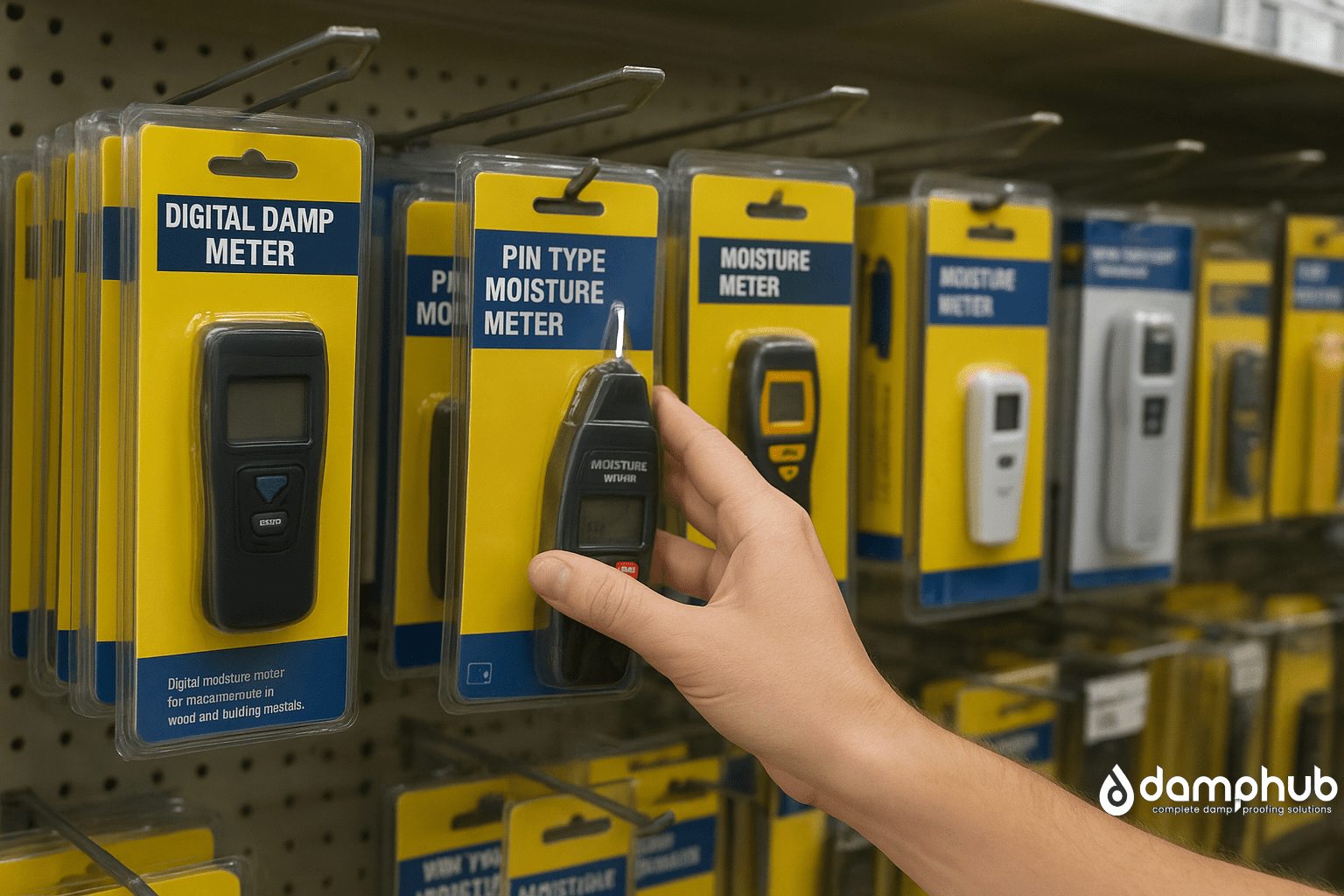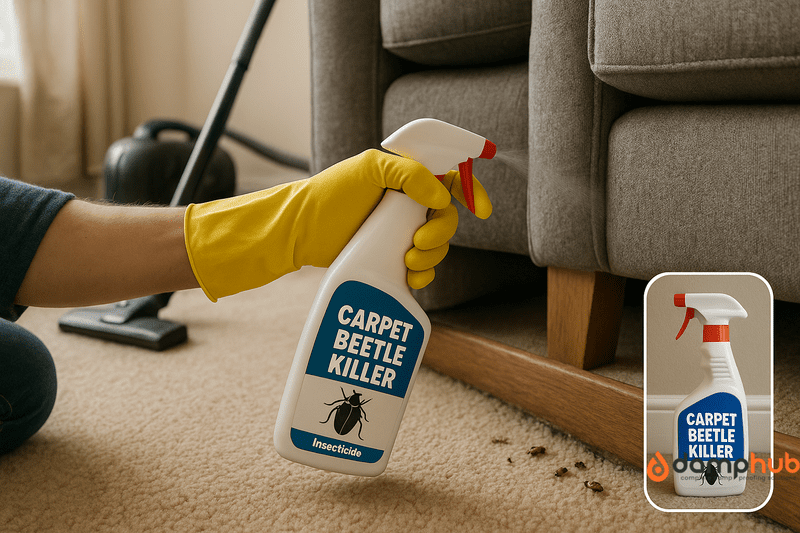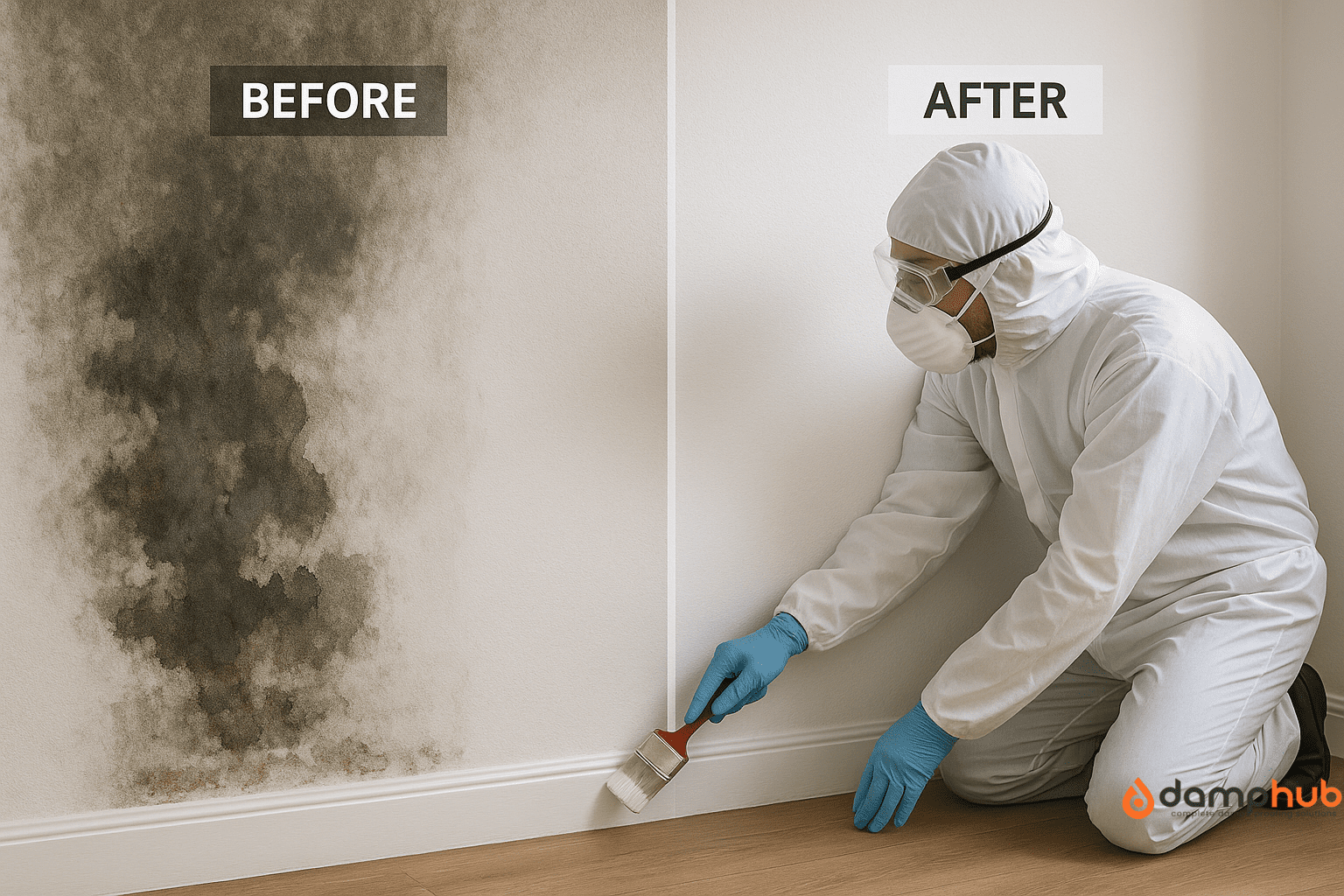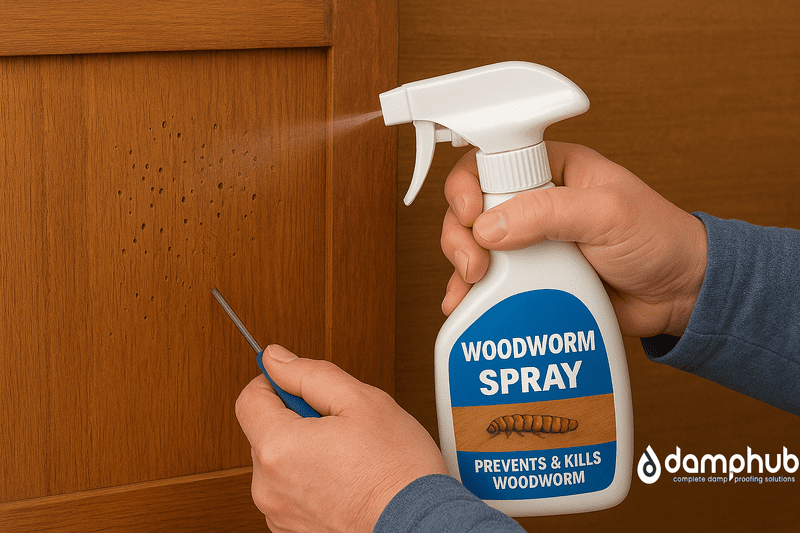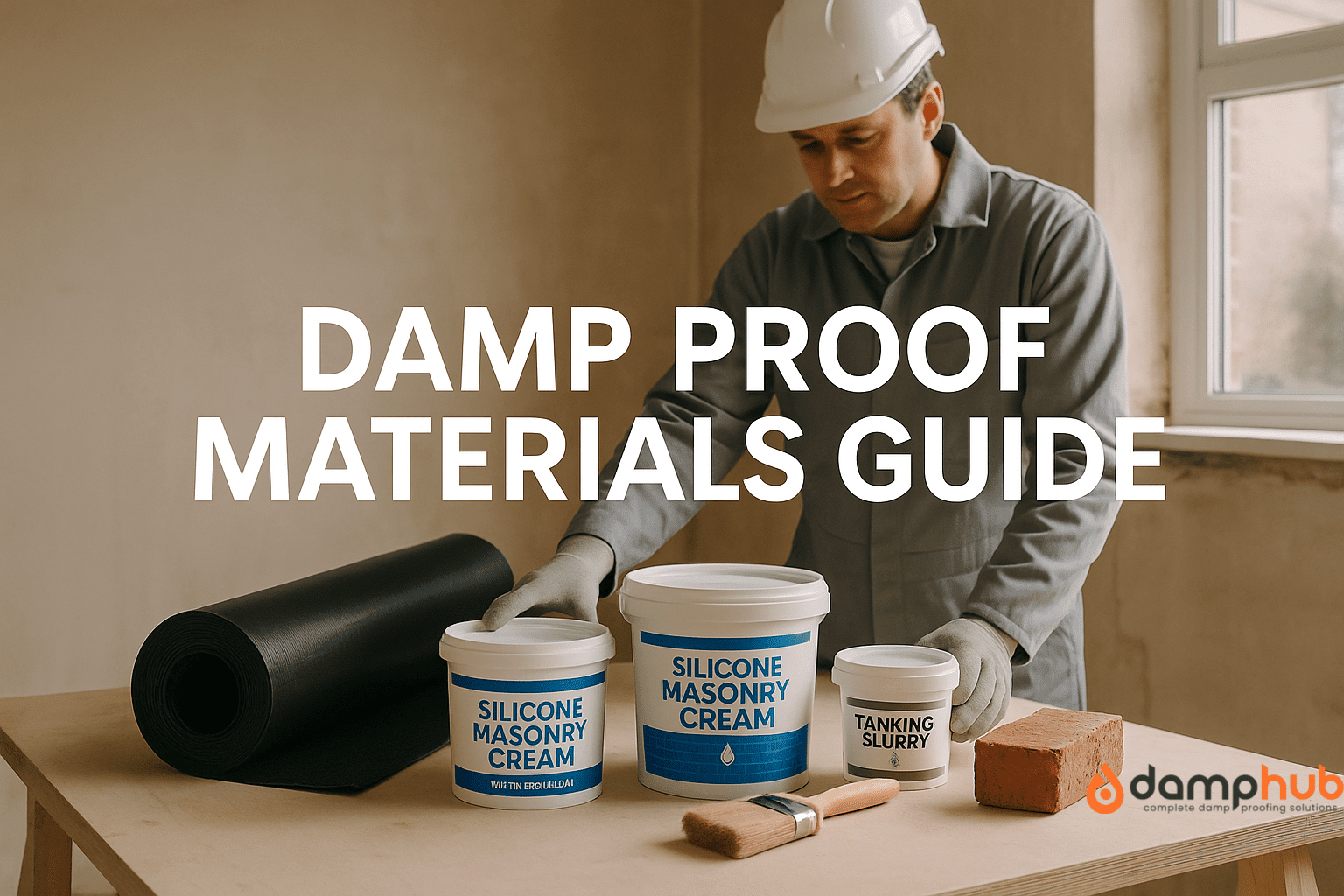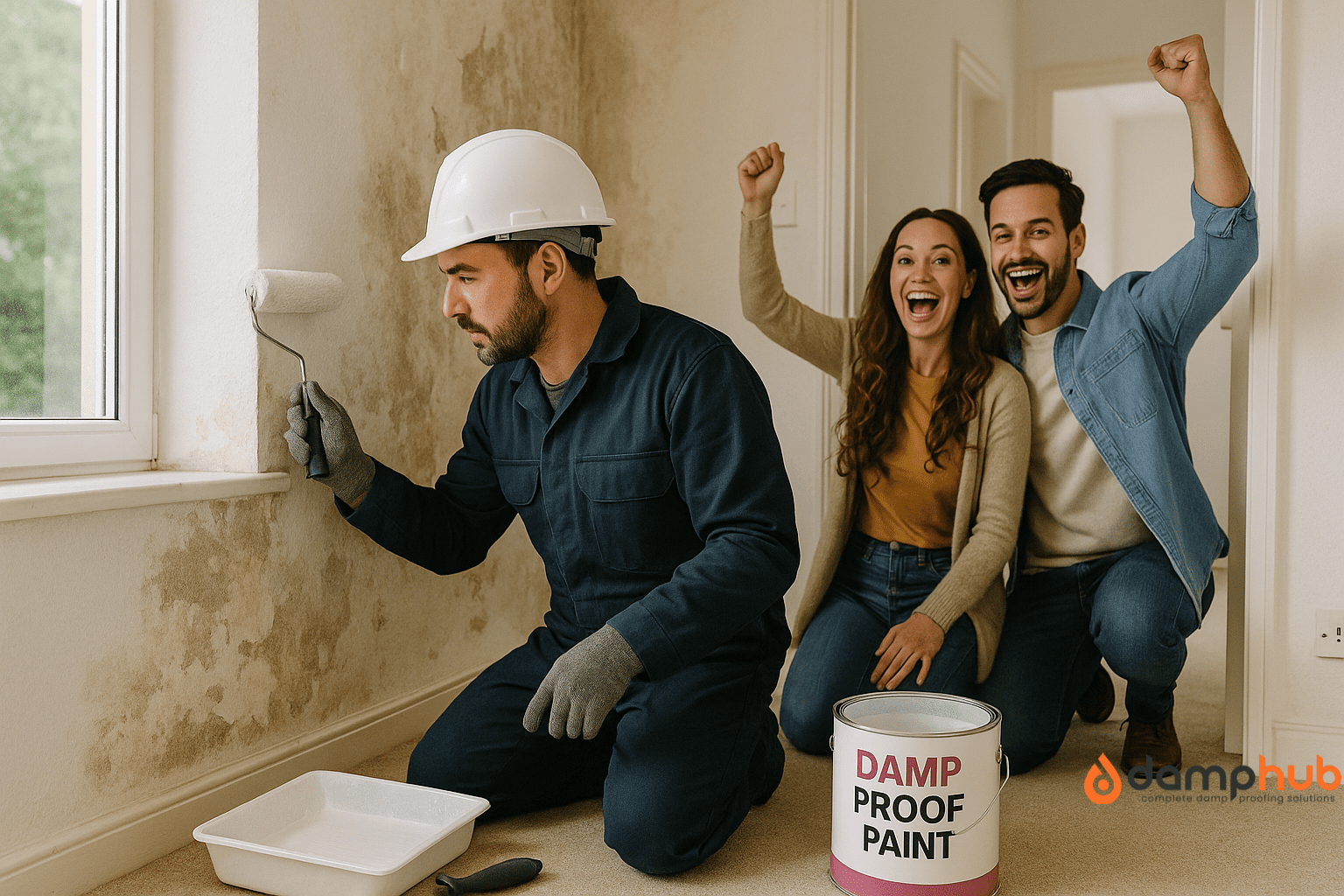
You’re staring at your wall, and there it is—bubbling paint wrecking your perfectly neat room.
“No worries,” you think, “I’ll just slap on a fresh coat of damp paint and sort the small issue ruining the beauty.”
That sounds easy enough, right?
But hang on a sec—before you dive in, take a minute to figure out why your paint’s acting up in the first place. Paint doesn’t just peel or bubble for no reason.
Usually, there’s something sneaky going on underneath; most often, it’s damp quietly taking toll behind the scenes.
Sure, it might look like a tiny patch now, but damp can be bothersome than you think.
Nearly 20% of UK homes deal with it every year, so if you spot it creeping into your place, you’re definitely not alone.
And here’s the kicker: just painting over it?
That’s like putting a fresh sticker on a cracked phone screen. It might look good for a bit, but the problem’s still there, ready to come back and cause more trouble.
Why?
Not all paints are made for damp, and using the wrong one can just make things worse.
In this guide, you’ll learn:
- The different types of damp that mess with your walls
- Why regular paint doesn’t cut it
- How to choose the right damp paints for damp areas
- The proper way to prep your wall before painting
- When it’s time to call in a professional
Let’s get started.
What’s Going On Behind Your Walls? Types of Damp You Need to Know
Damp isn’t just one thing. There are a few different types, and each one needs its own fix. If you’re not sure what kind you’re dealing with, here’s a simple way to tell them apart.
Rising damp: Comes up from the ground and gets into the lower part of your walls.
You’ll usually see marks that look like a tide line, or white powdery stuff on the plaster. Sometimes the paint or wallpaper starts peeling near the bottom of the wall.
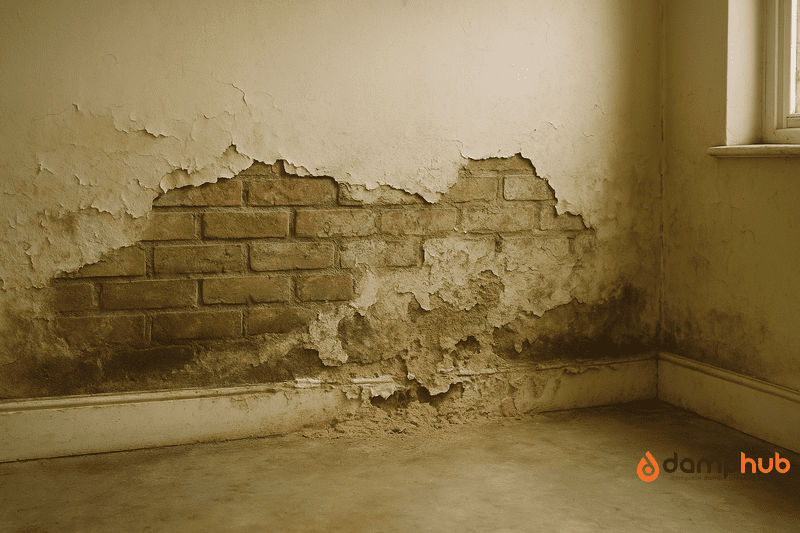
Penetrating damp: It is water coming in from outside.
It might be from cracked brickwork, leaky gutters, or broken roof tiles. If your wall looks wet after it rains, this is probably the reason. You might also notice stains or patches that keep growing over time.
Condensation: It is the one most people see inside their homes.
It happens when warm, damp air hits a cold wall or window and turns into little water droplets. This is really common in bathrooms after showers or in bedrooms with poor ventilation.
If you’ve spotted black mould in the corners, that’s usually from condensation.
Figuring out what type of damp you’ve got is super important. Once you know what’s causing it, it’s a lot easier to sort it out properly. You don’t want to just paint over it and hope for the best — that never works for long.
If you’re still not sure what’s going on, it might be time to bring in someone local who knows damp inside out. A proper damp survey can save you a lot of time and stress later on.
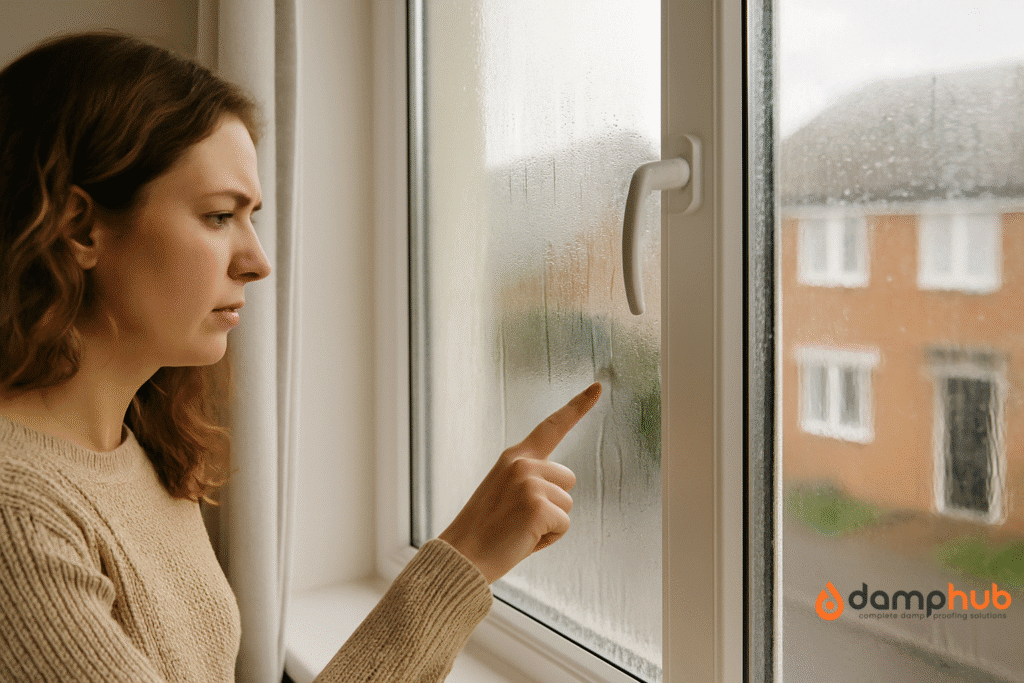
Why the Right Damp Paints Matter for Damp Walls
Painting over damp without understanding what’s going on beneath the surface is like sweeping dust under a rug.
Sure, it looks better for a while—but the problem’s still there. Regular paint isn’t designed to cope with moisture.
In fact, most standard emulsion or gloss paints trap water behind a sealed layer, which only worsens the situation.
That moisture builds up, weakens the plaster underneath, and leads to a paint job that cracks and crumbles in no time.
What makes damp-proof paints different is how they’re built.
These paints are formulated to either repel water, allow moisture to escape through breathable layers, or actively prevent mould growth.
Some act like waterproof jackets for your walls, while others let them breathe naturally, drying out slowly over time.
Choosing the right one depends on the type of damp you’re facing and where it’s happening in your home.
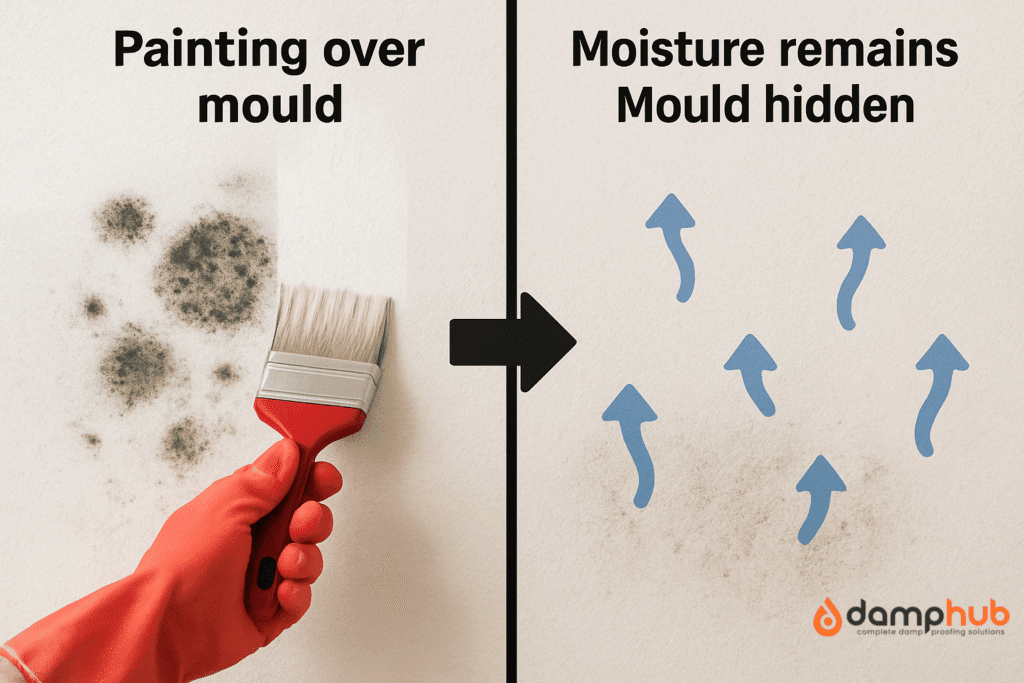
The Real Benefits of Using Paint Designed for Damp
Using the proper paint for a damp wall does more than improve appearances; it can help protect your home’s structure and air quality.
Here’s what you can expect:
- Prevents recurring damage: Specialised damp paints are far more resistant to peeling and bubbling, especially in rooms where moisture is a constant issue.
- Helps tackle mould: Anti-mould formulations include fungicides that actively stop mould spores from growing on painted surfaces.
- Improves insulation: Moisture makes walls feel cold and contributes to heat loss. Many damp-proof paints help retain warmth by stopping moisture transfer.
- Longer-lasting results: These paints are more durable under tough conditions, which means fewer touch-ups and repainting jobs in the long run.
- A cleaner, healthier home: Less damp and mould means a fresher-smelling, healthier environment for you and your family.
Think of it as painting with purpose.
Instead of masking the problem, you’re creating a defensive layer that fights back against moisture and all the damage it brings with it.
👉 Related Blog: What is Damp – A Complete Guide 2025
Best Types of Damp Paints to Use on Damp Interior Walls
All damp-proof paints aren’t created equal.
Some are designed to stop condensation, while others deal with rising damp or penetrating water.
Understanding your wall’s condition helps match it with the right solution.
1. Anti-Condensation Paint
Condensation builds up in areas like kitchens, bathrooms, or poorly ventilated rooms.
Anti-condensation damp paints contain insulating properties that reduce the temperature difference between the wall and the room air, helping prevent those telltale droplets.
It won’t fix leaks or rising damp, but it works well when humidity is the main culprit.
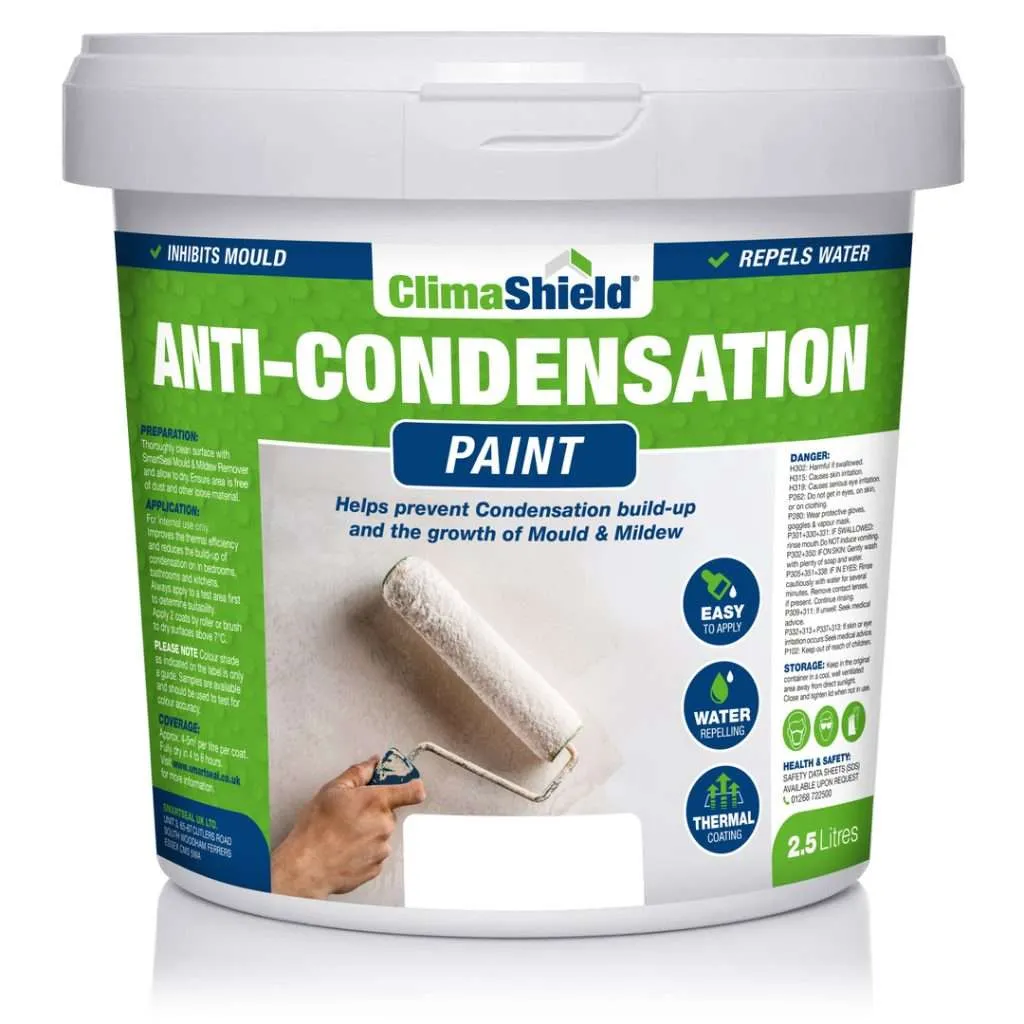
2. Anti-Mould Paint
This paint is ideal for areas where mould has been an issue in the past.
It’s typically combined with anti-condensation properties but focuses more on stopping fungal growth.
Anti-mould paint contains biocides that kill mould spores and stop them from settling.
Useful in bedrooms, utility rooms, or even around windows where black spots tend to appear.
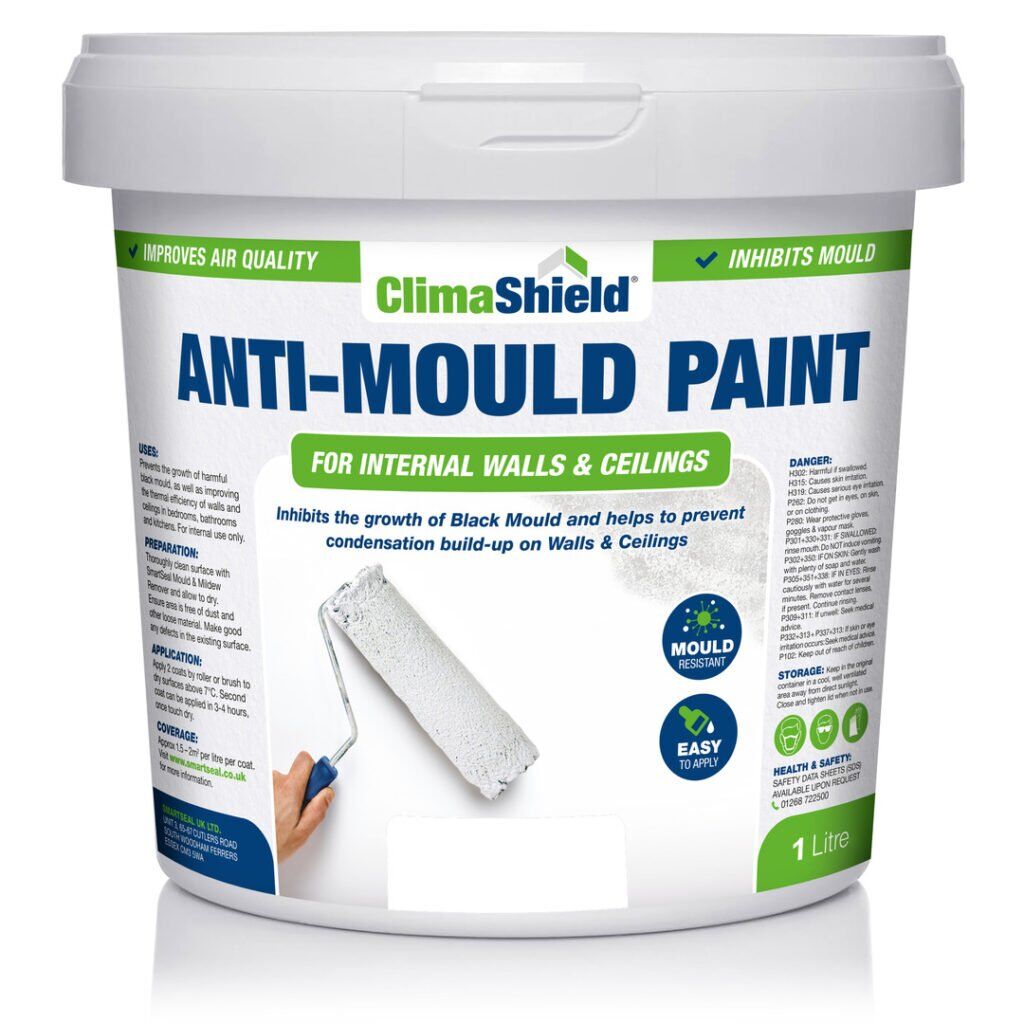
3. Waterproof / Damp-Proof Paint
This type forms a non-permeable barrier—ideal for basements, lower ground floors, or exterior-facing walls where water ingress is a known problem.
It creates a shield over your surface and blocks moisture from making its way through the wall.
Keep in mind, though: it only works if the source of damp has been dealt with first.
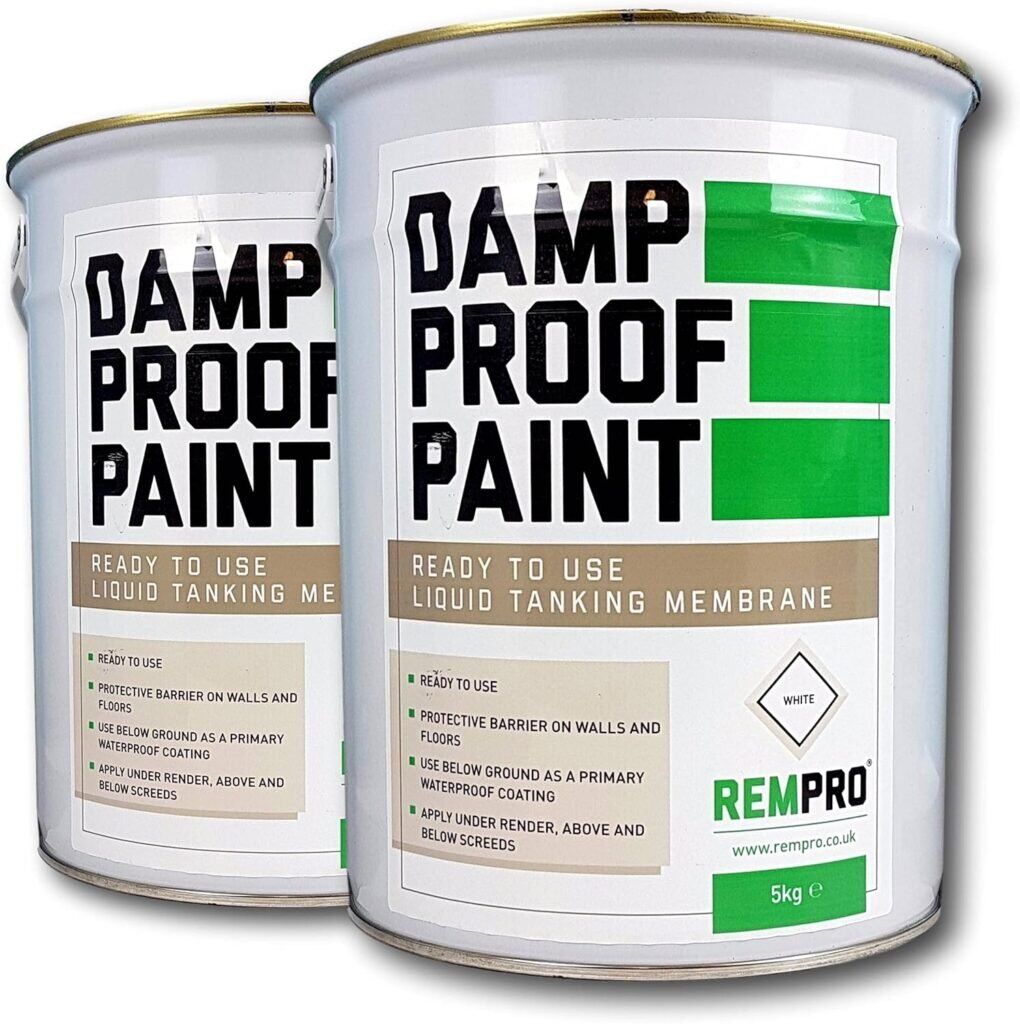
4. Silicone-Based Paint
Silicone-based paints are a smart pick for older homes with breathable brickwork.
They allow internal moisture to escape while repelling water from the outside.
It’s the best of both worlds and helps prevent trapped damp from causing further problems.
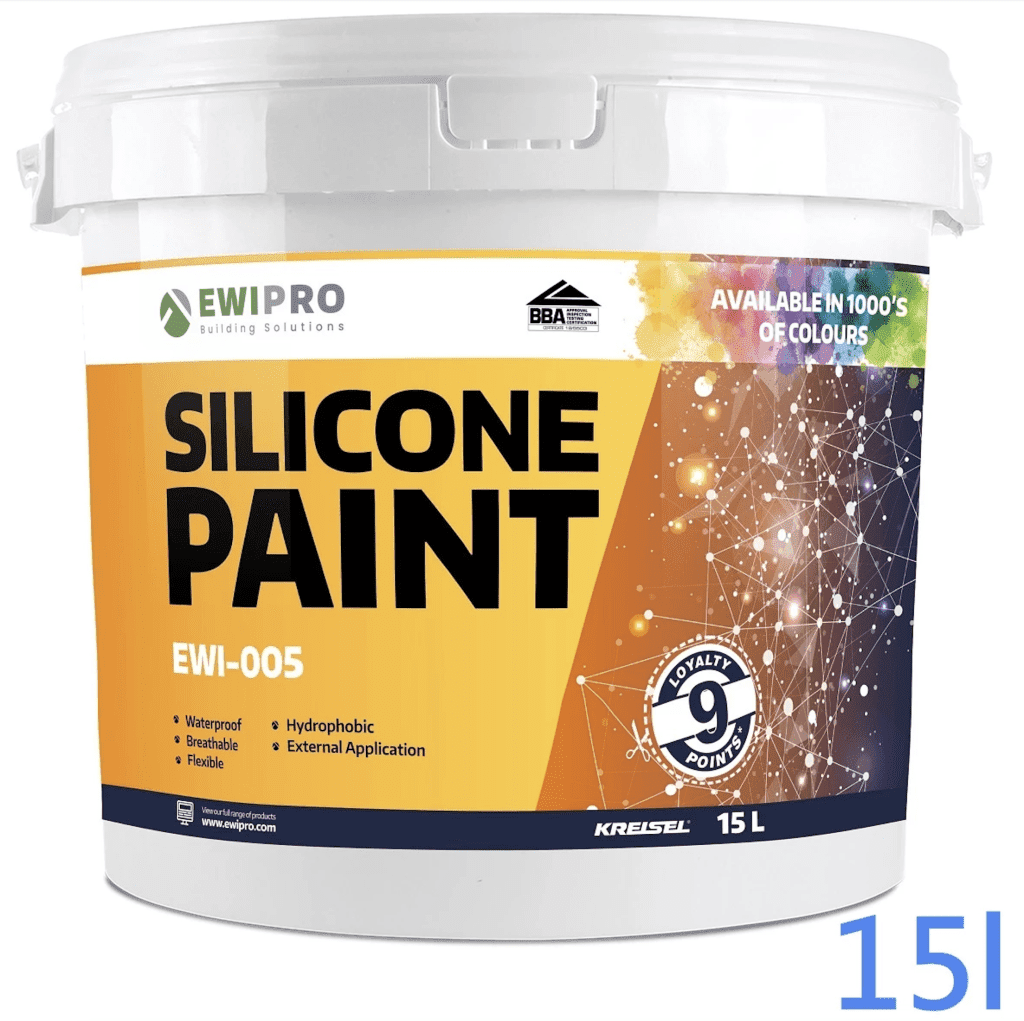
5. Breathable Paint
Breathable damp paints work differently than waterproof ones—they allow walls to dry out naturally by releasing moisture vapour into the air.
These are often recommended for heritage or period properties where the structure needs to “breathe” and sealing in moisture could cause long-term harm.
How to Choose the Right Paint for Damp Walls
Not all paints are built the same, especially when damp is involved.
If you just grab the cheapest tin off the shelf, you might end up with peeling, streaks, or worse, mould coming back through in weeks.
So, how do you pick the right one?
Think about the type of damp you’re dealing with
Know the enemy first.
- Rising damp? Go for waterproofing products.
- Condensation? Anti-condensation or anti-mould damp paints.
- Penetrating damp? Fix the external issue first, then seal and protect.
Check if the wall is inside or outside
Some paints are made for internal walls only.
Others are tough enough to handle the British weather on the outside of your home.
If you’re painting a cold, external wall from the inside, look for breathable options.
These allow trapped moisture to escape instead of getting sealed in.
Look for extra features
Some damp-proof paints come with built-in mould resistance.
Others include stain-blocking or even thermal insulation.
If you’ve had mould problems in the past, choosing one with a fungicidal barrier is a smart move.
Don’t skip the label
This might sound boring, but always read the back of the tin.
Some damp paints need a primer. Others are two-in-one.
Check the drying time, coverage, and whether it’s water-based or oil-based.
These small details can make a big difference.
Stick to trusted brands
It’s tempting to go for a bargain, but damp-proofing isn’t the place to cut corners.
Go for brands that have been tested in UK homes and have solid reviews.
A slightly higher price upfront can save you the cost of repainting the whole room six months later.
Choosing the right damp-proof paint isn’t just about colour.
It’s about picking a product that will protect your walls, stop moisture in its tracks, and keep your home looking fresh for longer.
👉 Related Blog: Who Can Carry Out a Damp Survey?
Top UK Damp-Proof Paints Worth Trying (And Why They Work)
Not all damp paints are created equal.
Some are made to fight off mould, others are better at handling steamy rooms, and a few are tough enough to deal with serious water stains.
The trick is knowing which one fits your problem best.
Let’s break down five of the UK’s most trusted damp-proof paints — not just by name, but by what they’re actually good for:
Ronseal Anti-Condensation Paint
This one’s a hero for steamy rooms like bathrooms, kitchens, and laundry spaces.
It works by forming a special insulating layer on the wall, which helps reduce surface temperature so moisture doesn’t turn into water droplets.
Less condensation means fewer damp patches.
Bonus: You can paint over it with any colour after it dries.
Best for: Condensation on cold interior walls
Why it’s great: Quick-drying, low odour, and adds thermal resistance
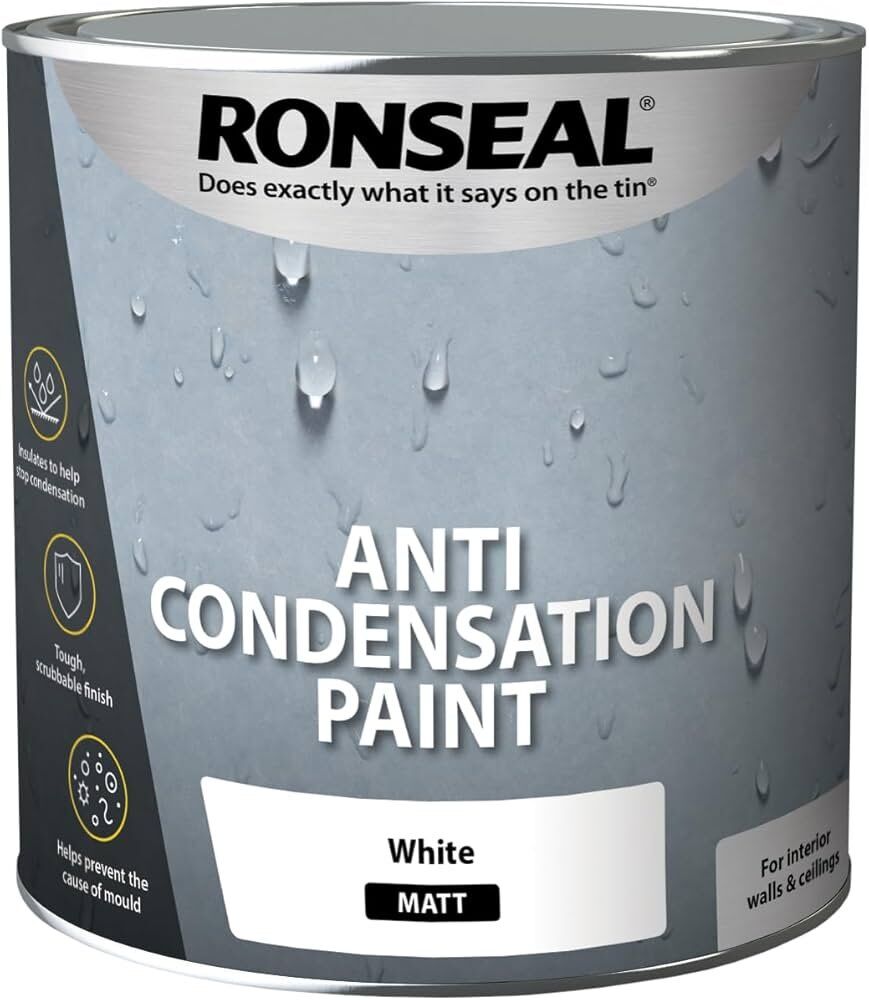
Zinsser Perma-White Mould Resistant Paint
If mould is your main enemy, this is your weapon.
It’s self-priming, moisture-resistant, and packed with mould-killing ingredients that stop spores from growing back.
Works wonders in high-humidity zones, and you can scrub it clean without damaging the finish.
Best for: Mould-prone rooms with poor ventilation
Why it’s great: Washable, tough finish, and keeps mould away for years.
Leyland Trade Damp Seal
Think of this one as a solid backup when your walls already have stains or patches from damp.
It seals in the mess and creates a clean surface so new paint sticks better.
It’s not a topcoat — more like a base layer that stops old problems from showing through.
Best for: Covering damp stains before repainting
Why it’s great: Fast drying, blocks old marks, and budget-friendly
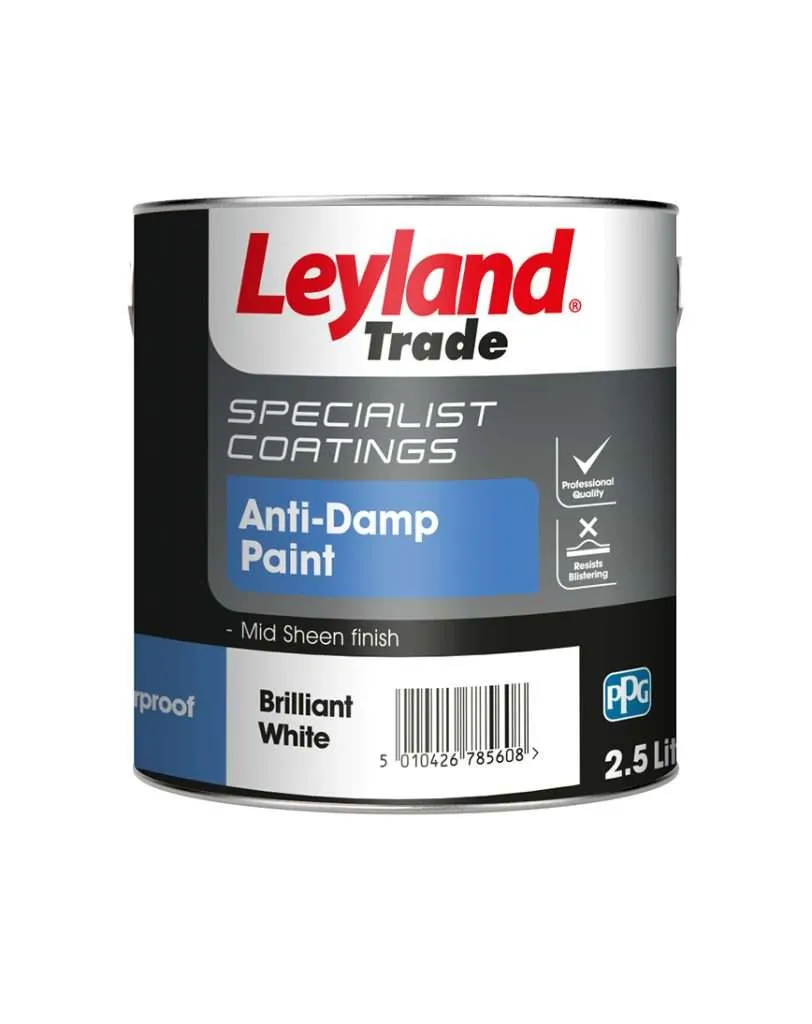
Sandtex Microseal Masonry damp Paints
Need something breathable for both indoors and out?
This paint has you covered.
It’s weatherproof, water-resistant, and lets moisture escape, so it’s ideal for older buildings that need airflow through the walls.
The silicone in it helps stop rain from soaking in while letting trapped moisture breathe out.
Best for: Exposed interior walls or exterior brick and render
Why it’s great: Long-lasting, dirt-resistant, and flexible in bad weather
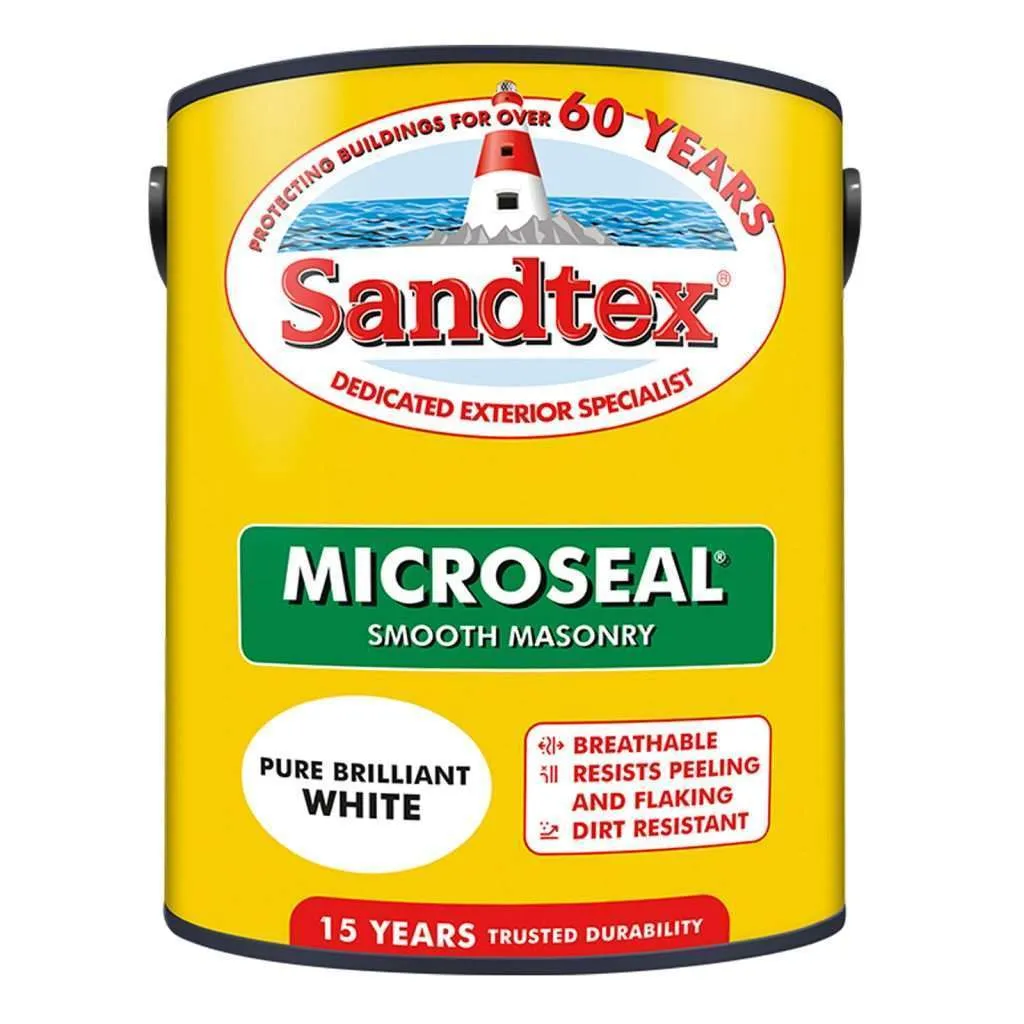
Johnstone’s Anti-Mould Paint
A great pick for homes that always seem to attract black spots in corners and behind furniture.
It uses a fungicidal barrier to stop mould from growing, even in cool, still areas. It’s a white matt finish by default — simple, clean, and does what it says on the tin.
Best for: Bedrooms, hallways, or anywhere with stale air
Why it’s great: Keeps surfaces mould-free without constant cleaning
These paints won’t magically fix damp all on their own — you still need to sort out what’s causing the moisture.
But if your walls are prepped and your home is properly ventilated, these products can make a big difference in keeping damp and mould from creeping back.
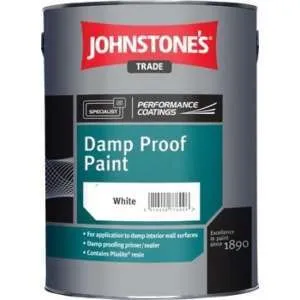
How to Prepare and Paint Damp Walls the Right Way
Most paint jobs on damp walls go wrong before the paint even goes on. It’s usually not the paint’s fault. The real problem is that the wall wasn’t ready.
If you want your paint to last, you’ve got to prep the surface properly. Here’s how to do it step by step.
Start by finding the source of the damp
Don’t just paint over it and hope for the best.
You need to figure out where the moisture is coming from.
- Is it rising from the floor?
- Sneaking in through a crack in the wall? or
- Caused by poor ventilation or steam from daily life?
Until that issue is fixed, the damp will keep coming back no matter what paint you use.
Make sure the wall is completely dry
Even waterproof damp paints need a dry surface to work properly.
If the wall feels damp, cold, or soft, it’s not ready.
Use a fan, a heater, or a dehumidifier to help it dry out faster.
Be patient here. Painting over a wet wall is a waste of time.
Clean the wall well
Scrape off any loose or peeling paint.
Get rid of mould or mildew with a proper cleaner or diluted bleach.
Wipe away dust and grease with a sponge and warm water.
You want the surface clean, smooth, and free from anything that might stop the paint from sticking.
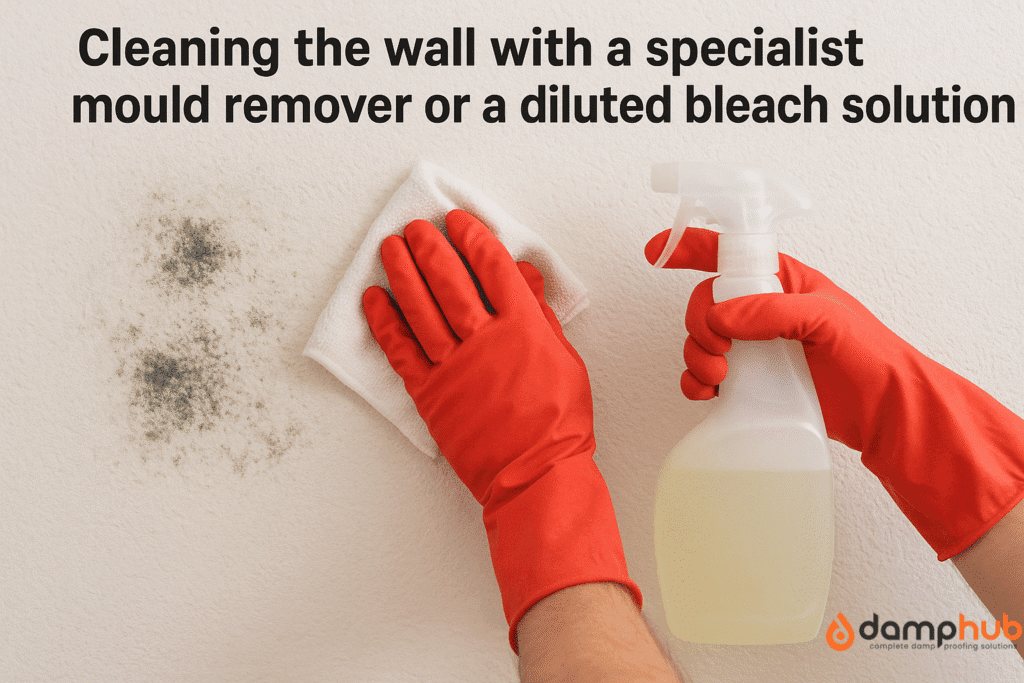
Apply a suitable primer or sealant
Not all walls need this, but if you’re dealing with stains or stubborn damp patches, a good primer can help.
It seals the surface and gives the topcoat something solid to grip onto.
Some damp-proof paints include a primer, but always check the label to be sure.
Use two coats of paint
One coat of damp paint might look okay, but it won’t give you strong protection.
Two coats last longer, cover better, and help seal out moisture.
Let the first coat dry completely before adding the second.
Keep the room well-ventilated
After painting, open windows or run a fan.
Fresh air helps the paint cure properly and stops new condensation from building up.
Take your time with the prep, and your paint will do its job.
No flaking. No bubbling. Just a clean, smooth finish that stays that way.
When to Call a Professional Damp Specialist
Sometimes, no matter how much you scrape, clean, or paint, the damp just keeps coming back. That’s your sign—it might be time to call in the pros.
Here’s when you shouldn’t try to DIY it anymore:
The smell won’t go away
If your room still smells musty no matter how much you air it out or clean, there’s probably deep-seated damp or hidden mould.
A pro can trace it back to its source—whether it’s inside the walls or under the floor.
Your damp paints keep bubbling or peeling
Even after following all the right steps, if the paint still flakes off within weeks or months, the wall might be too wet for any surface treatment to work.
You could be dealing with rising damp or damaged plaster
You see tide marks or brown stains
Tide marks (those yellowish lines near the bottom of walls) usually mean rising damp.
That’s moisture coming up through brickwork, and no paint can hold it back for long.
This often needs a chemical damp-proof course or major repair—definitely not a DIY job.
Your damp patch keeps growing
If that damp area is getting bigger over time, something’s still feeding it.
It might be a leaking pipe, a crack in your wall, or poor drainage outside.
Either way, it won’t stop until it’s professionally sorted.
There’s visible black mould
Small patches of mould can be cleaned, but if you see recurring black mould on your walls, especially in corners or around windows, it can be a health risk.
Professionals have the right tools to remove it safely and prevent it from coming back.
Why Calling in a Damp Treatment Expert Makes Sense
Damp professionals can spot hidden issues that most homeowners miss.
They’ll check moisture levels inside the walls, diagnose the exact problem, and recommend real solutions—not just cosmetic fixes.
Yes, it costs more upfront, but it can save you hundreds in repeat paint jobs or even structural repairs later.
So if you’ve tried everything and your walls still feel damp, don’t stress, just bring in the experts and let them get to the root of the problem.
Is Damp-Proof Paint the Only Fix You Need?
Not quite.
While damp paints are fantastic tools, they’re part of a bigger picture.
If you don’t tackle the source of damp, like faulty guttering, rising groundwater, or bad ventilation, no paint can save you long-term.
Use these damp paints as finishing touches after you’ve sorted the core issue.
They’re brilliant at preserving dry walls, preventing new problems, and adding a layer of protection.
But they’re not a substitute for proper damp diagnosis or building repairs.
For long-term success, think of paint as one of the final steps, not the first.
👉 Related Blog: How Much Does Rising Damp Treatment Cost?
FAQs
How long does damp paint last?
Damp-proof paint can last 5 to 10 years when applied correctly, depending on the brand, surface, and how well the wall was prepared.
But here’s the key: if the cause of the damp (like a leaking pipe or rising damp) isn’t fixed first, even the best paint won’t last.
It’ll peel, bubble, or flake much sooner.
What is the difference between damp proof paint and waterproof paint?
They sound similar, but they work differently:
Damp proof paint blocks moisture from the inside — like water coming through walls or from condensation. It’s breathable, which means it lets trapped moisture escape.
Waterproof paint is made to resist external water — like rain hitting an outside wall. It forms a thicker barrier and often works best outdoors or in places with direct water contact.
Think of damp proof paint as fighting moisture inside, and waterproof paint as fighting water outside.
What is the permanent solution for a damp wall?
There’s no one-size-fits-all fix, but the permanent solution is to find and fix the cause of the damp, not just paint over it.
That could mean:
Repairing leaks
Improving ventilation
Installing a new damp-proof course
Injecting damp-proof cream into walls
Tanking the wall if it’s below ground
Once that’s sorted, then you paint — otherwise, the damp will just come back.
What is a damp seal?
A damp seal is a special kind of primer that blocks existing damp stains from bleeding through your new paint.
It’s not a full fix for rising or penetrating damp — it’s more like a stain blocker.
You apply it before painting to stop those ugly brown or yellow marks from showing up again.
What is better: damp proofing or waterproofing?
It depends on where the moisture is coming from.
If your walls are damp because of moisture inside the house (like condensation or rising damp), then damp proofing is what you need.
If the issue is external water pressure, like from heavy rain or a leaky basement, waterproofing is better.
In many homes, a mix of both is used — for example, waterproofing outside walls and damp-proofing inside walls.
Need help choosing the right paint or dealing with stubborn damp? Reach out to a local damp surveyor to get your walls assessed before you start decorating.
Painting is a powerful tool—but only when it’s used the right way.

